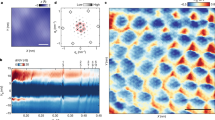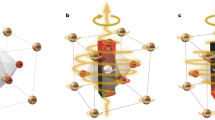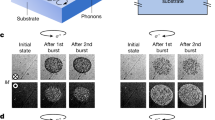Abstract
In soft ferromagnetic materials, the smoothly varying magnetization leads to the formation of fundamental patterns such as domains, vortices and domain walls1. These have been studied extensively in thin films of thicknesses up to around 200 nanometres, in which the magnetization is accessible with current transmission imaging methods that make use of electrons or soft X-rays. In thicker samples, however, in which the magnetization structure varies throughout the thickness and is intrinsically three dimensional, determining the complex magnetic structure directly still represents a challenge1,3. We have developed hard-X-ray vector nanotomography with which to determine the three-dimensional magnetic configuration at the nanoscale within micrometre-sized samples. We imaged the structure of the magnetization within a soft magnetic pillar of diameter 5 micrometres with a spatial resolution of 100 nanometres and, within the bulk, observed a complex magnetic configuration that consists of vortices and antivortices that form cross-tie walls and vortex walls along intersecting planes. At the intersections of these structures, magnetic singularities—Bloch points—occur. These were predicted more than fifty years ago4 but have so far not been directly observed. Here we image the three-dimensional magnetic structure in the vicinity of the Bloch points, which until now has been accessible only through micromagnetic simulations, and identify two possible magnetization configurations: a circulating magnetization structure5 and a twisted state that appears to correspond to an ‘anti-Bloch point’. Our imaging method enables the nanoscale study of topological magnetic structures6 in systems with sizes of the order of tens of micrometres. Knowledge of internal nanomagnetic textures is critical for understanding macroscopic magnetic properties and for designing bulk magnets for technological applications7.
This is a preview of subscription content, access via your institution
Access options
Access Nature and 54 other Nature Portfolio journals
Get Nature+, our best-value online-access subscription
$29.99 / 30 days
cancel any time
Subscribe to this journal
Receive 51 print issues and online access
$199.00 per year
only $3.90 per issue
Buy this article
- Purchase on Springer Link
- Instant access to full article PDF
Prices may be subject to local taxes which are calculated during checkout



Similar content being viewed by others
References
Hubert, A. & Schäfer, R. Magnetic Domains: The Analysis of Magnetic Microstructures (Springer, 1998)
Arrott, A. S., Heinrich, B. & Aharoni, A. Point singularities and magnetization reversal in ideally soft ferromagnetic cylinders. IEEE Trans. Magn. 15, 1228–1235 (1979)
Shin, S., Schäfer, R. & De Cooman, B. C. Three-dimensional visualization of the magnetic microstructure in bulk Fe-6.6 pct Si. Metall. Mater. Trans. A 44, 4239–4247 (2013)
Feldtkeller, E. Mikromagnetisch Stetige und Unstetige Magnetisierungskonfigurationen. Z. Angew. Phys. 19, 530 (1965)
Elías, R. G. & Verga, A. Magnetization structure of a Bloch point singularity. Eur. Phys. J. B 82, 159 (2011)
Braun, H.-B. Topological effects in nanomagnetism: from superparamagnetism to chiral quantum solitons. Adv. Phys. 61, 1–116 (2012)
Gutfleisch, O. et al. Magnetic materials and devices for the 21st century: stronger, lighter, and more energy efficient. Adv. Mater. 23, 821–842 (2011)
Streubel, R. et al. Retrieving spin textures on curved magnetic thin films with full-field soft X-ray microscopies. Nat. Commun. 6, 7612 (2015)
Phatak, C., Petford-Long, A. K. & De Graef, M. Three-dimensional study of the vector potential of magnetic structures. Phys. Rev. Lett. 104, 253901 (2010)
Phatak, C. et al. Visualization of the magnetic structure of sculpted three-dimensional cobalt nanospirals. Nano Lett. 14, 759–764 (2014)
Tanigaki, T. et al. Three-dimensional observation of magnetic vortex cores in stacked ferromagnetic discs. Nano Lett. 15, 1309–1314 (2015)
Hertel, R. Curvature-induced magnetochirality. Spin 3, 134009 (2013)
Streubel, R. et al. Magnetism in curved geometries. J. Phys. D 49, 363001 (2016)
Arrott, A. S. Visualization and interpretation of magnetic configurations using magnetic charge. IEEE Magn. Lett. 7, 1108505 (2016)
Andreas, C., Kákay, A. & Hertel, R. Multiscale and multimodel simulation of Bloch-point dynamics. Phys. Rev. B 89, 134403 (2014)
Hertel, R. & Schneider, C. M. Exchange explosions: magnetization dynamics during vortex–antivortex annihilation. Phys. Rev. Lett. 97, 177202 (2006)
Thiaville, A. et al. Micromagnetic study of Bloch-point-mediated vortex core reversal. Phys. Rev. B 67, 094410 (2003)
Hertel, R. Ultrafast domain wall dynamics in magnetic nanotubes and nanowires. J. Phys. Condens. Matter 28, 483002 (2016)
Kardjilov, N. et al. Three-dimensional imaging of magnetic fields with polarized neutrons. Nat. Phys. 4, 399–403 (2008)
Manke, I. et al. Three-dimensional imaging of magnetic domains. Nat. Commun. 1, 125 (2010)
Holler, M. et al. High-resolution non-destructive three-dimensional imaging of integrated circuits. Nature 543, 402–406 (2017)
Donnelly, C. et al. High-resolution hard x-ray magnetic imaging with dichroic ptychography. Phys. Rev. B 94, 064421 (2016)
Phatak, C., Beleggia, M. & De Graef, M. Vector field electron tomography of magnetic materials: theoretical development. Ultramicroscopy 108, 503–513 (2008)
Burzo, E. Paramagnetic behavior of some rare-earth cobalt compounds. Phys. Rev. B 6, 2882–2887 (1972)
Chukazumi, S. in Physics of Ferromagnetism Ch. 7.2 (Oxford Univ. Press, 2009)
Stoehr, J. & Siegmann, H. Magnetism: From Fundamentals to Nanoscale Dynamics Ch. 9 (Springer, 2006)
Scagnoli, V. et al. Linear polarization scans for resonant X-ray diffraction with a double-phase-plate configuration. J. Synchrotron Radiat. 16, 778–787 (2009)
Schäfer, R. Domains in ‘extremely’ soft magnetic materials. J. Magn. Magn. Mater. 215–216, 652–663 (2000)
Chen, Y.-T. et al. Full-field hard x-ray microscopy below 30 nm: a challenging nanofabrication achievement. Nanotechnology 19, 395302 (2008)
Cloetens, P. et al. Holotomography: quantitative phase tomography with micrometer resolution using hard synchrotron radiation x rays. Appl. Phys. Lett. 75, 2912–2914 (1999)
Eriksson, M., van der Veen, J. F. & Quitmann, C. Diffraction-limited storage rings—a window to the science of tomorrow. J. Synchrotron Radiat. 21, 837–842 (2014)
Thibault, P., Guizar-Sicairos, M. & Menzel, A. Coherent imaging at the diffraction limit. J. Synchrotron Radiat. 21, 1011–1018 (2014)
Holler, M. et al. X-ray ptychographic computed tomography at 16 nm isotropic 3D resolution. Sci. Rep. 4, 3857 (2014)
Rodenburg, J. M. et al. Hard-x-ray lensless imaging of extended objects. Phys. Rev. Lett. 98, 034801 (2007)
Thibault, P. et al. High-resolution scanning x-ray diffraction microscopy. Science 321, 379–382 (2008)
Tripathi, A. et al. Dichroic coherent diffractive imaging. Proc. Natl Acad. Sci. USA 108, 13393–13398 (2011)
Giles, C. et al. Energy-dispersive phase plate for magnetic circular-dichroism experiments in the X-ray range. J. Appl. Cryst. 27, 232–240 (1994)
Dierolf, M. et al. Ptychographic X-ray computed tomography at the nanoscale. Nature 467, 436–439 (2010)
Henrich, B. et al. PILATUS: A single photon counting pixel detector for X-ray applications. Nucl. Instrum. Meth. A 607, 247–249 (2009)
Kraft, P. et al. Characterization and calibration of PILATUS detectors. IEEE Trans. Nucl. Sci. 56, 758–764 (2009)
Guizar-Sicairos, M. & Fienup, J. R. Phase retrieval with transverse translation diversity: a nonlinear optimization approach. Opt. Express 16, 7264–7278 (2008)
Thibault, P. & Guizar-Sicairos, M. Maximum-likelihood refinement for coherent diffractive imaging. New J. Phys. 14, 063004 (2012)
Bouchenoire, L. et al. Performance of phase plates on the XMaS beamline at the ESRF. J. Synchrotron Radiat. 10, 172–176 (2003)
Guizar-Sicairos, M., Thurman, S. T. & Fienup, J. R. Efficient subpixel image registration algorithms. Opt. Lett. 33, 156–158 (2008)
Guizar-Sicairos, M. et al. High-throughput ptychography using Eiger: scanning X-ray nano-imaging of extended regions. Opt. Express 22, 14859–14870 (2014)
Guizar-Sicairos, M. et al. Phase tomography from x-ray coherent diffractive imaging projections. Opt. Express 19, 21345–21357 (2011)
Guizar-Sicairos, M. et al. Quantitative interior x-ray nanotomography by a hybrid imaging technique. Optica 2, 259–266 (2015)
Hannon, J. P. et al. X-ray resonance exchange scattering. Phys. Rev. Lett. 61, 1245–1248 (1988)
van Heel, M. & Schatz, M. Fourier shell correlation threshold criteria. J. Struct. Biol. 151, 250–262 (2005)
Howells, M. R. et al. An assessment of the resolution limitation due to radiation-damage in x-ray diffraction microscopy. J. Electron Spectrosc. Relat. Phenom. 170, 4–12 (2009)
Acknowledgements
X-ray measurements were performed at the cSAXS beamline at the Swiss Light Source, Paul Scherrer Institut, Switzerland. We thank R. M. Galera for providing and performing magnetic characterizations of the GdCo2 nugget, and S. Stutz and E. Müller for the sample fabrication, as well as K. Metlov, A. Arrott and G. Hrkac for discussions. S.G. was funded by the European Union’s Horizon 2020 research and innovation programme under Marie Skłodowska-Curie grant agreement number 708674.
Author information
Authors and Affiliations
Contributions
J.R. and L.J.H. conceived the project. C.D., M.G.-S., V.S., M.H. and J.R. designed the experiment. M.H. and J.R. modified the instrument for the 30° tilt measurement. C.D., M.G.-S., V.S., M.H. and J.R. performed the experiment. C.D. and M.G.-S. developed the vector tomography reconstruction algorithm. C.D. performed the data analysis (with support from M.G.-S. and V.S.). C.D., S.G. and J.R. interpreted the magnetic results. C.D., M.G.-S. and S.G. wrote the manuscript with contributions from all authors.
Corresponding authors
Ethics declarations
Competing interests
The authors declare no competing financial interests.
Additional information
Publisher's note: Springer Nature remains neutral with regard to jurisdictional claims in published maps and institutional affiliations.
Extended data figures and tables
Extended Data Figure 1 Transmission spectrum obtained with spectroscopic ptychography.
a, Absorption part of a ptychographic reconstruction of the pillar measured at 7.203 keV. Regions of air and material are highlighted by the blue and red boxes, respectively. These regions were used to obtain the transmission of the sample at different energies. Such images were measured for a range of energies between 7.203 keV and 7.282 keV in steps of 1.5 eV. b, The transmission spectrum obtained from the range of images is shown, and the difference in absorption across the absorption edge, Δedge, is indicated.
Extended Data Figure 2 Validation of the magnetic reconstruction.
Single polarization images for different angles about the rotation axis (0°, 30° and 60°) in the 30° tilt geometry are shown in the left-hand column. In the central column, XMCD projections obtained by taking the difference between images measured with circular left and right polarization are given, which are the integrals of the magnetic component along the path of the X-ray beam. The equivalent projections obtained from the reconstructed magnetic tomogram are given in the right-hand column. When we compare the images in the central and right columns, the contrast and projection of the magnetization match well. This good agreement provides a validation for the magnetic reconstruction.
Extended Data Figure 3 Structure of the magnetization surrounding the singularity shown in Fig. 3f.
a, View parallel to the plane of the domain wall shown in Fig. 3c; b, view perpendicular to the plane of the domain wall shown in Fig. 3c. The observed magnetic structure does not show a one-to-one correspondence to any of the Bloch point configurations in Fig. 3g–i. While circulating Bloch points have been shown to minimize the magnetostatic energy as result of their swirling magnetization, this is not the case for other Bloch point configurations, where the magnetization in the vicinity of the singularity is predicted to deform in order to minimize the magnetostatic energy. We therefore attribute the structure above to the redistribution of the magnetization in order to screen the magnetostatic charge associated with the monopole generated by the diverging magnetization at the Bloch point.
Extended Data Figure 4 Estimation of the spatial resolution obtained by resolving nearby structures.
a–c, Streamlines showing the direction of the magnetization for three x–z slices at heights of 0 nm (midway through the pillar), +20 nm and +40 nm. A vortex–antivortex pair draw closer together as the height increases until they merge and can barely be resolved. d–f, The absolute value of the magnetization  is shown for the same areas as a–c, where the cores of the vortex and antivortex are minima. g–i, The
is shown for the same areas as a–c, where the cores of the vortex and antivortex are minima. g–i, The  line profiles along the dotted lines in d–f, where we show that we are able to resolve features in the vector field that are separated by approximately 126 nm (h), the structure of which can be seen clearly in b, whereas in i the two structures can no longer be resolved.
line profiles along the dotted lines in d–f, where we show that we are able to resolve features in the vector field that are separated by approximately 126 nm (h), the structure of which can be seen clearly in b, whereas in i the two structures can no longer be resolved.
Extended Data Figure 5 Estimation of the spatial resolution using FSC.
a–c, The spatial resolution of the single components of the magnetization vector— mx (a), my (b) and mz (c)—are found to be 195 nm, 250 nm and 196 nm, respectively. The spatial resolution of my is lower because of lower sampling resulting from the experimental geometry, as explained in the text. d–f, To estimate the spatial resolution of the vector field, the FSC values are calculated for  (d),
(d),  (e) and
(e) and  (f) to be 125 nm, 97 nm and 127 nm, respectively. The x–y and y–z planes exhibit lower spatial resolution, owing to the low sampling of my caused by the experimental geometry.
(f) to be 125 nm, 97 nm and 127 nm, respectively. The x–y and y–z planes exhibit lower spatial resolution, owing to the low sampling of my caused by the experimental geometry.
Extended Data Figure 6 The correspondence of the three-dimensional region in Fig. 3c with the axial slice of Fig. 2a.
Supplementary information
Circulating Bloch point
The magnetic configuration in the vicinity of an energetically stable circulating Bloch point. The magnetic structure is shown in a radius of 125 nm. (AVI 11026 kb)
Twisted magnetic structure surrounding an anti-Bloch point
The magnetic configuration in the vicinity of an energetically unstable anti-Bloch point. The magnetisation is twisted to shield the Bloch point structure at length scales greater than the exchange length. The magnetic structure is shown in a radius of 125 nm. (AVI 10087 kb)
Intersection of a magnetic vortex with a vortex domain wall
The intersection of a magnetic vortex (purple-orange tube) with a vortex domain wall (white surface with a blue-red core). Across the intersection points the direction of the magnetisation in the core of the vortex (indicated by the colour) reverses (from red to blue, and orange to purple). At these points, magnetic singularities occur. (AVI 16733 kb)
Rights and permissions
About this article
Cite this article
Donnelly, C., Guizar-Sicairos, M., Scagnoli, V. et al. Three-dimensional magnetization structures revealed with X-ray vector nanotomography. Nature 547, 328–331 (2017). https://doi.org/10.1038/nature23006
Received:
Accepted:
Published:
Issue Date:
DOI: https://doi.org/10.1038/nature23006
This article is cited by
-
Real space iterative reconstruction for vector tomography (RESIRE-V)
Scientific Reports (2024)
-
Manipulation of the magnetic monopole injection for topological transition
NPG Asia Materials (2024)
-
A fast magnetic vector characterization method for quasi two-dimensional systems and heterostructures
Scientific Reports (2023)
-
Probing of three-dimensional spin textures in multilayers by field dependent X-ray resonant magnetic scattering
Scientific Reports (2023)
-
Bloch points in nanostrips
Scientific Reports (2023)
Comments
By submitting a comment you agree to abide by our Terms and Community Guidelines. If you find something abusive or that does not comply with our terms or guidelines please flag it as inappropriate.



